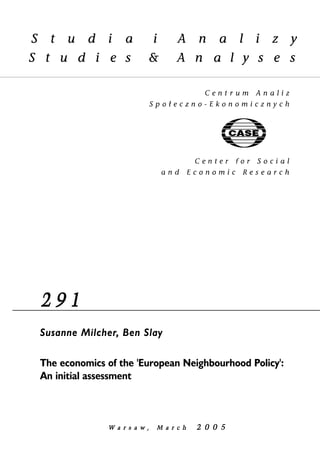This document discusses the economics of the European Neighbourhood Policy (ENP), analyzing its potential impacts on the EU and its neighboring countries. It emphasizes that the ENP aims to enhance cooperation and economic integration but faces challenges due to unclear accession incentives for neighboring nations. The authors suggest that while the ENP can foster trade and investor confidence, its effectiveness largely depends on the attractiveness of the benefits offered to encourage necessary governance reforms.

















![Studies & Analyses No. 291 – Susanne Milcher, Ben Slay – The economics of the ‘European Neighbourhood Policy’...
References
Aslund, A. and Warner, A. (2004), ‘The EU Enlargement: Consequences for the CIS Countries’ in: Dabrowski, M.,
Slay, B. and Neneman, J. (2004). Beyond Transition: Development Perspectives and Dilemmas. Ashgate.
Centre for Economic Reforms, (2005), ‘Study of Azerbaijan’s Current and Potential Comparative Advantages’, Baku.
Dodini, M. and Fantini, M. (2004), The European Neighbourhood Policy: Implications for Economic Growth and
Stability. Forthcoming. CEPS. http://www.ceps.be.
Economic Intelligence Unit (EIU), (2004) Country Report Moldova. The Economist Intelligence Unit Limited.
Ellerman, D. (2004), ‘Migration, Transition, and Aid: Three development themes relevant for South-East Europe’ in:
Stojanov, D. (ed.) The Southeast European Journal of Economics and Development. Sarajevo: Economics Faculty
of the University of Sarajevo and UNDP.
Emerson, M. (2004), Two cheers for the European Neighbourhood Policy. CEPS. http://www.ceps.be.
European Commission (EC) (2003), Communication from the Commission to the Council and the European
Parliament on the development of energy policy for the enlarged European Union, its neighbours and partner
countries. Brussels: Commission of the European Communities.
EC. (2004a), European Neighbourhood Policy. Country Report. Moldova. Brussels: Commission of the European
Communities. Commission Staff Working Paper.
EC. (2004b), European Neighbourhood Policy. Strategy Paper. Brussels: Commission of the European Communities.
EC. (2004c), European Neighbourhood Policy. Country Report. Ukraine. Brussels: Commission of the European
Communities. Commission Staff Working Paper.
EC. (2004d), External Relations. http://www.europa.eu.int/comm/external_relations.
Global Insight (2004), PlanEcon Report, Quarterly Data Supplement. Washington, D.C.: Global Insight. Vol. XX,
No.3. June 2, 2004.
Global Insight (2005), ‘PlanEcon Report, Development in the Economies of Central Europe and Russia’, Global
Insight, Vol. XX, No.17, 4 February 2005.
Klein, M. (2003), Ways out of Poverty – Diffusing Best Practices and Creating Capabilities. Perspectives on Policies
for Poverty Reduction. Washington, D.C.: The World Bank. World Bank Policy Research Working Paper 2990.
Martin, C. and Turrion, J. (2001), The trade impact of the integration of the Central and Eastern European Countries
on the European Union. Madrid: European Economy Group. Working Paper no.11/2001.
Mau, V., Russia’s Relations with the EU: Problems and Prospects’, [in:] Dabrowski, M., Slay, B. and Neneman, J.
(2004). Beyond Transition: Development Perspectives and Dilemmas. Ashgate.
Mencinger, J. (2004), ‘Does Foreign Direct Investment Always Enhance Economic Growth?’ in: Stojanov, D. (ed.) The
Southeast European Journal of Economics and Development. Sarajevo: Economics Faculty of the University of
Sarajevo and UNDP.
Mizsei and Maddock (2005), Unemployment in the Western Balkans: a synoptic diagnosis, UK: Edward Elgar
(forthcoming).
Podkaminer, L. et al. (2004), Transition Countries on the Eve of EU Enlargement. Vienna: The Vienna Institute for
International Economic Studies. WIIW Research Reports 303.
UNDP. (2004), Reversing The Epidemic: Facts And Policy Options, HIV/AIDS in Eastern Europe and the
Commonwealth of Independent States. Bratislava: UNDP. Regional Human Development Report.
Verheugen, G. (2004), The European Neighbourhood Policy. Speech delivered at Prime Ministerial Conference of
the Vilnius and Visegrad Democracies: ‘Towards a Wider Europe: the new agenda’. Bratislava.
18](https://image.slidesharecdn.com/291-141105042636-conversion-gate01/85/CASE-Network-Studies-and-Analyses-291-The-economics-of-the-European-Neighbourhood-Policy-An-initial-assessment-18-320.jpg)